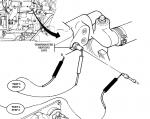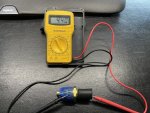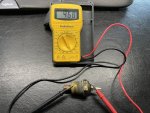I have two gauges that I need to test/diagnose. I have gone through the -20 but my meter battery is out and, of course, it is a cr2032. Off to Wally World. That said, the testing procedure for most electrical things asks for frame ground or engine ground. Given the multiple coats of paint, grease, oil, and rust, I'd prefer I have a very solid ground so I don't get a mis-read. Is there any reason why I can't just make a wire with alligator clips on the battery and connect my meter to that when it calls for a ground? In the end, doesn't the frame strap to the engine which straps to the battery?
The two gauges in question are the oil pressure and the temp.
The temp sensor isn't doing anything so I need to test the gauge and the sender. I want to make sure I have a good ground
The oil pressure sensor jumps to about 20-ish PSI when I flip the accessory switch with the engine off. As soon as I press start it jumps to about 60 and then about 10-15 seconds later it jumps to about 100.
Clearly I need to run some tests and figure out what's wrong with these two. The others work fine on the panel -- i.e. fuel, tach, speedo, voltage, air pressure.
The two gauges in question are the oil pressure and the temp.
The temp sensor isn't doing anything so I need to test the gauge and the sender. I want to make sure I have a good ground
The oil pressure sensor jumps to about 20-ish PSI when I flip the accessory switch with the engine off. As soon as I press start it jumps to about 60 and then about 10-15 seconds later it jumps to about 100.
Clearly I need to run some tests and figure out what's wrong with these two. The others work fine on the panel -- i.e. fuel, tach, speedo, voltage, air pressure.






